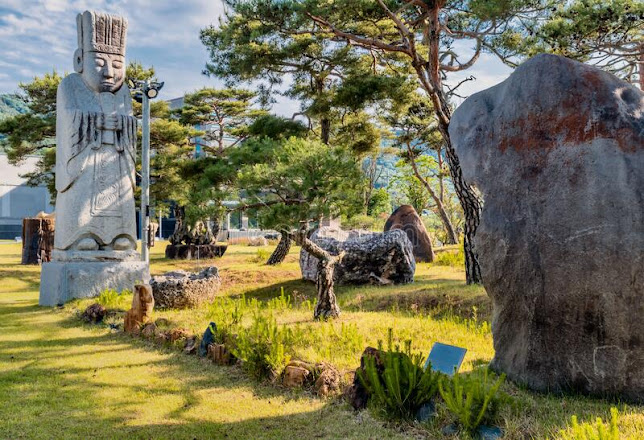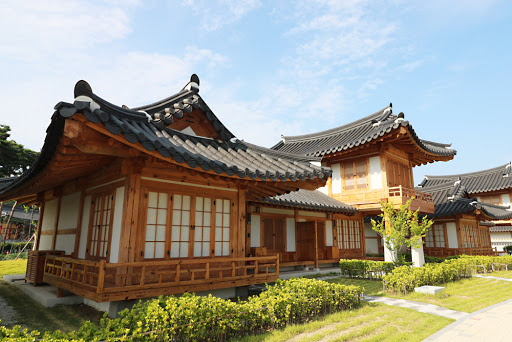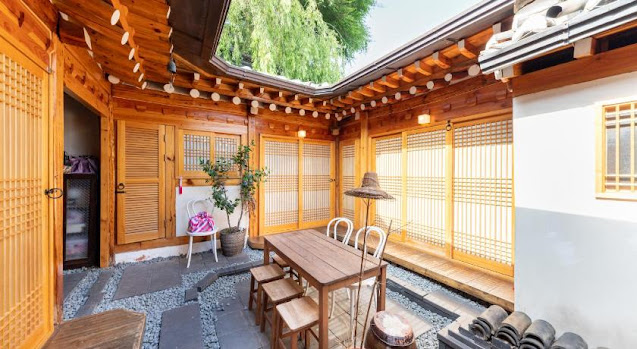Most of Korean gardens have one thing in common which is the balance of forces. The Korean garden approach is pretty philosophical and pragmatic at the same time. The design of the Korean Garden was influenced by three different pillars of thought: Buddhism, the teachings of Confucius and popular shamanic belief. The latter teaches us the balance of male and female forces in nature. Only together can the male figure ("Knight of the Sky") and the female figure ("Knight of the Earth") unfold their full power as a guardian spirit. You will find the pair at the entrance and at the exit of the village. The Korean Garden is authentic garden art in the Korean tradition. Special features of the garden are the abstract wooden figures and totem poles, which refer to the partly shamanic culture of Korea. Koreans appeal to them for protection and help.
The varied landscape is an authentic reflection of Korean nature. Surrounded by rocky landscapes, you’ll find the tree species typical of Korea: pine, bamboo, oak and Japanese maple. In addition, four courtyards with lavishly designed gates and masonry invite you to linger. Built on rocks, the central structure of the complex is "Kye Zeong" (pavilion on the water), and, as its name suggests, it is located directly on the water. In it you will find some typical Korean living rooms.
The crucial elements of a typical Korean garden
A typical Korean garden complex consists of three different sections: open spaces and courtyards, called “Ma-Dang”, a pavilion, and a landscape like Korea’s real natural rocky landscape with its typical Korean vegetation. Pine trees, bamboo, oaks, and Japanese maples are among the trees planted. Usually three to four-walled courtyards, each with differently designed gates, and a pavilion built on rocks at the water’s edge. Like for example the “Kye Zeong” (pavilion at the water’s edge) contains living spaces once typical in Korea.
Zang Sung, Buk Su and Sot Da - Korean shamanism
The various wooden figures and totem poles are testimonies of Korea’s shamanic culture. Totem poles called "Zang Sung" and large wooden figures are used to address the wishes of the people; the smaller figures are to protect against natural disasters such as fire or flood and epidemics. They are called "Buk Su". Birds are given a special role in communication with the spirit world: The so-called "Sot Da" sit at the head of the shamanic spirit poles and are said to act as messengers, carrying the prayers of the people to the spirits in the upper worlds.
Dol hareubangs, also called tol harubangs, hareubangs, or harubangs, are large rock statues found on Jeju Island off the southern tip of South Korea. They are considered to be gods offering both protection and fertility and were placed outside of gates for protection against demons traveling between realities.
Description
Dol hareubangs are carved from porous basalt (volcanic rock) and can be up to three metres high. The statues' faces feature grinning expressions, bulging eyes without pupils, a long, broad nose, and slight smile, and their hands rest on their bellies, one slightly above the other. In sets of two, one has a higher left hand, and the other a higher right hand. The hat is commonly described as phallic or mushroom-like.
Etymology
The name dol hareubang derives from the Korean word for "stone" (dol 돌), plus the Jeju dialect word hareubang (하르방), meaning "grandfather" or "senior" (harabeoji [할아버지] in Standard Korean), and was coined in the mid-20th century. Other earlier names for the statues include beoksumeori, museongmok, and useongmok. Beoksumeori, meaning shaman head, is used in the former area of Jeongui Hyeon (county), museongmok in Daejeong Hyeon and Jeongui Hyeon, and useongmok only in Jeju Hyeon. Historically, the Tamna Chronicles called them ongjungseok (옹중석/翁仲石), but this usage is unknown today.
An other interesting aspect beside Hanok village landscapes, gardens is KNF (Korean Natural Farming) which can be used for the benefit of any type of plants or tree.
Korean Organic Natural Farming explained
Korean natural farming is a self-sufficient farming system that involves the culturing of indigenous microorganisms (IMO) – bacteria, fungi, nematodes, and protozoa – in place of inorganic fertilizers to produce fertile soil. Soil plays a vital role in our ecosystem; without it, life for many multicellular organisms would cease to exist. In addition, food shortages are driven by soil degradation, as poor farming practices lead to loss of nutrients through erosion and leaching. To maximize crop yield, it is imperative that farmers maintain a healthy environment for plants to grow, as the quality of the soil can change the outcome of the harvest. The most common way to replenish the soil is by adding fertilizer to it. However, the maintenance of fertile soil does not come cheap. Fertilizers and other soil additives can be expensive, especially in Hawai‘i, due to the higher costs of shipping. Korean natural farming (KNF) has been proposed as an attractive alternative for farmers and gardeners who wish to become less dependent on external inputs.
The famous korean natural farming book Jadam shows you how to make natural pesticides that can replace chemical ones. He started organic farming and raised animals himself from 1991 in Asan, Chungnam province. He went on to establish "Jadam Organic Farming" and started to promote this farming system through books and website (www.jadam.kr). He established "Jadam Natural Pesticide Institute" in 2002 from where he continued his research while integrating knowledge from many experienced farmers which led to the completion of the system of ultra-low cost Jadam organic farming. He invented and developed many technologies for a natural pesticide which he voluntarily did not patent but rather shared through books and website. His "Natural Pesticide Workshops" teaches the essence of ultra-low-cost Jadam organic farming.
Related blogpost: Bonsai in Korea or The principles of natural farming (Masanobu Fukuoka)
Natural inputs used to make the IMO (Cho 2010) Very important graph explains the principles of IMO. Details and crucial steps can be found in the PDF document published by the university of Hawaii Manoa.
Interesting Books on Bonsai can be found here:
The Complete Book of Bonsai --> I've been into bonsai for 25 years and this is the basic Bible for beginner and intermediate bonsai enthusiasts. It has an excellent section on techniques, including pruning, wiring and whatnot, and it has a large species-specific tree guide. If you're into bonsai and want only one book, this is it.
Indoor Bonsai The Great Selection --> Creating beautiful, healthy bonsai is a wonderful skill that anyone can learn, with a little time, patience, and this all-inclusive manual. With color photos and drawings to illustrate the points, it introduces all the cultivation techniques; offers expert advice on location, soil types, watering, and pest control; and provides intricate instruction on training the bonsai--including pruning, wiring and stretching it.
The Secret Techniques of Bonsai --> In The Secret Techniques of Bonsai, the author of the groundbreaking Bonsai With American Trees teams up with his son to offer not only the basics for creating perfect bonsai, but also secret techniques they’ve developed over years of careful work and observation.
Bonsai Survival Manual --> Problem solving when your Bonsai get sick. Expand your gardening repertoire as you create a captivating and exquisite miniature world. In this introductory guide, Colin Lewis covers everything you need to know to design, grow, and successfully maintain attractive bonsai.
Bonsai and the art of Penjing --> Bonsai & Penjing, Ambassadors of Beauty and Peace describes how Chinese penjing and North American bonsai were later added to the Museum, making its collection the most comprehensive in the world. Stories of individual trees and forest plantings are featured, as are the roles played by the skilled and talented creators of these living art forms people such as John Naka, Saburo Kato, Yuji Yoshimura, Harry Hirao, and Dr. Yee-Sun Wu.
Bonsai and the art of Penjing --> Bonsai & Penjing, Ambassadors of Beauty and Peace describes how Chinese penjing and North American bonsai were later added to the Museum, making its collection the most comprehensive in the world. Stories of individual trees and forest plantings are featured, as are the roles played by the skilled and talented creators of these living art forms people such as John Naka, Saburo Kato, Yuji Yoshimura, Harry Hirao, and Dr. Yee-Sun Wu.
Bonsai with Japanese Maples --> With their delicate foliage, seasonal color changes, and intricate pattern of branching, Japanese maples are among the most popular and suitable plants for bonsai design. In this long-awaited book, internationally renowned expert Peter Adams discusses both the specific horticultural needs of Japanese maples as bonsai subjects and illustrates proven techniques for creating and maintaining beautiful specimens.
The Modern Bonsai Practice --> The most current, useful information on growing Bonsai. Fresh, practical, definitive, comprehensive reference guide to the finest art of horticulture: growing miniature trees. Common sense bonsai answers separating myth from fact with depth and detail. Appropriate for both bonsai hobbyists and experienced practitioners.









No comments:
Post a Comment